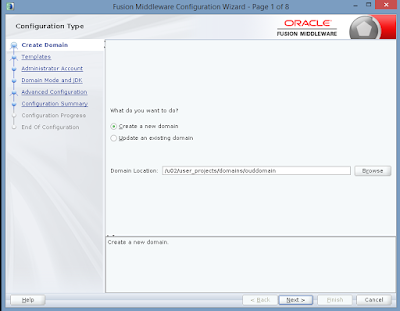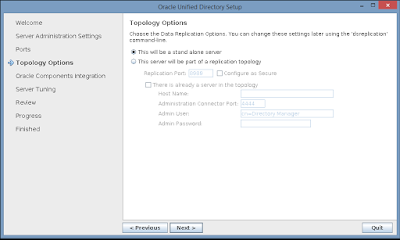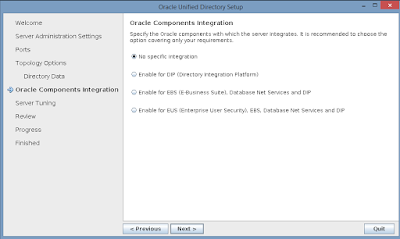Installation
of Oracle Unified Directory 12c Software and 12c Infrastructure Software In
Collocated Mode
Installation
of OUD and OUDSM Software
Installation
of 12c "Oracle Fusion Middleware
infrastructure" Software must be done as a first step
Installation of OUD and OUDSM Software.
1. Installation of 12c "Oracle Fusion Middleware
infrastructure"
Software must be done as a first step.
Software must be done as a first step.
Execute following command and follow the screen shots.
1.1 .Go to the location where
software’s are placed in your environment
1.2.
Inside OIMInfra you should be able to see fmw_12.2.1.3.0_infrastructure_Disk1_1of1
1.3 Execute below command and follow the screen shots.
Once you hit enter on above
command you should be able to get GUI window for installation
and below screen shots are as following:
and below screen shots are as following:
2. Choose whichever option you need.
Here it has been selected option
to skip Auto updates.
to skip Auto updates.
3.Choose the directory into which Infrastructure
must be installed.
Select Oracle_HOME as
/u02 and select Next
(In my case Oracle_Home is /u02 defined your location
as per your environment)
(In my case Oracle_Home is /u02 defined your location
as per your environment)
4. In Installation Fusion Middleware Infrastructure is selected by
default.
5. Select Next and wait for completion to 100%.
6. In installation summary if you want to save Response File save it and
click on Install
2. Installation of OUD12C
2.1 .Go to the location where
software’s are placed in your environment
In my case it is /home/oracle/IDAM12C/OUD
2.4 In my case installation type is Collocated, and install OUD.
Collocated mode would expect FMW
Infrastructure installed in Oracle Home
Screen shots for reference are as
following:
1. Select Next
2. Choose whichever option you need. Here it has been
selected option to
skip Auto updates.
skip Auto updates.
Select Next
3. Choose the directory into which Infrastructure must
be installed.
Select Oracle_HOME as
/u02 and select Next (In my case Oracle_Home is /u02
defined your location as per your environment)
defined your location as per your environment)
4.In Installation type Collocated Mode is selected.
In Other option Standalone is not allowed since we have
chosen Infrastructure
Oracle Home location in previous step.
Oracle Home location in previous step.
Select Next.
5. Click on Next and wait until its completes 100%
6. In installation summary if you want to save Response File save it and
click on Install
7. Wait for it to complete 100%. Select Next.
8. Click on Finish
3. To Configure OUD & OUDSM in the same domain .That is in Collocated
Mode.
1. Creation of Schema using RCU: Creating database schema using
Repository Creation
Utility to be installed and configured. The database should be up and running.
Utility to be installed and configured. The database should be up and running.
1.1. Start the RCU – Execute
following command
/u02/oracle_common/bin/rcu
In this case we are using
location /u02/oracle_common/bin/rcu
Screen shots are as follows below
1.2. Once if you hit. /rcu you will get GUI
window
In Repository Creation Utility welcome screen
Select Next
1.3. In Create
Repository by default
“Create Repository” and
“System Load and Product Load” is selected. Select Next
“System Load and Product Load” is selected. Select Next
1.4. In Database connection details you must provide your Oracle
Database details
and click on Next
and click on Next
Note:-Ensure your Oracle Database is up and running. Note
here
“Connection Parameters”option is selected. And Database
Type selected is “Oracle Database”.
“Connection Parameters”option is selected. And Database
Type selected is “Oracle Database”.
1.5. Here it
will check for prerequisites and select ok once it completes.
1.6. In Select components select create
New Prefix and provide a value. It can be any.
In my case DEV2 is given. And also choose Oracle Platform Security Services
schema as below.
In my case DEV2 is given. And also choose Oracle Platform Security Services
schema as below.
1.7 In my case DEV2 is given.
And also choose Oracle Platform Security Services schema as below and
click on Next.
And also choose Oracle Platform Security Services schema as below and
click on Next.
1.8. Here it will check for component Prerequisites, once
checking is done select ok.
1.9. In Schema Passwords section in my case I am using same password for all
schema is selected by default.
schema is selected by default.
2.0. In Map Tablespaces screen select Next
2.1. Select Ok on pop up window
2.2. Select Ok on pop up window once it completes
2.3. Save response file if required for reference. Note down
database details
2.4. Save response file and click on create
2.5. Once it is complete in completion summary note down rcu log
and
other log paths it shows.
other log paths it shows.
And click on Close
4. Configuring OUD/OUDSM domain using the configuration wizard
1.1 In my case in following
below location /u02/oracle_common/common/bin
1.3 Following below screen appears
Default Create a new Domain is selected.
It would be the same as OUD
and Infrastructure directory Path (in my case it is /u02/)
under which, Domain must be created.
under which, Domain must be created.
In my case Domain Location is /u02/user_projects/domain/ouddomain
1.4. Choose Oracle Unified Directory -12.2.1.3.0 [oud] and
Oracle Unified Directory Service
Manager - 12.2.1.3.0[oud] template
under Templates wizard screen.
under Templates wizard screen.
Note that this makes Oracle JRF
auto selected.
1.7. In Administrator Account provide a username.
Weblogic is the default username it takes.
Weblogic is the default username it takes.
1.8. In Domain Mode and JDK choose either of the option.
Here in my case Development is selected.
Here in my case Development is selected.
Ensure JDK path is correct.
1.9. In Database Configuration Type select auto configuration type as RCU
data in my case
I have selected as RCU Data if you want to select Manual Configuration you
can go ahead with Manual configuration also
I have selected as RCU Data if you want to select Manual Configuration you
can go ahead with Manual configuration also
2.0 Provide database details in which schemas were created using RCU in
previous step,
under Database Configuration Type screen.
under Database Configuration Type screen.
Under Connection Parameters provide correct details.
2.1. Click on Get RCU Configuration you should able
to see a successfully
done message at bottom of the screen. Then click on Next to continue
done message at bottom of the screen. Then click on Next to continue
2.3. In JDBC test ensure that test selected are successful .Once
successful click on Next
2.2. In Advanced Configuration do not select any component until
and unless
if you want to set some advanced configurations.
if you want to set some advanced configurations.
Here by default administration Server will be configured and
OUDSM will be
deployed on Admin Server.
deployed on Admin Server.
2.3.In Configuration Summary below is displayed next. And select Create.
2.4. In Configuration Process you must see the next screen with
100%.
Then select Next and note down the
Domain Location and Admin Server URL.
Then select
Finish
2.5 In End Configuration you can able to see Domain Location and
Admin Server URL.
Then click on
Finish
Testing:-
1. Go to below path and start Weblogic
server.
/u01/user_projects/domains/oiamdomain/bin/startWeblogic.sh
2. Access the OUDSM URL from Chrome,
Firefox or I.E etc... and verify its working fine.
WLS Console http://domainname:7001/console
OUDSM Console http://domain:7001/oudsm
5. To create an instance for OUD 12c.
1.1 As per my environment, go to
the below following location as per screen shots placed
below
1.3. Once you get GUI prompt of Oracle Unified Directory Setup
1.4 In Server Administration Settings
Mention your Instance Path, Hostname,
Administration Port, Root User DN, Password and
Confirm Password
Once you fill all the attributes click on
Next.
1.5. In Ports in my case I have selected LDAP and Enabled Port on 1389 and click on Next
1.6. In Topology Options by default it is selected as Standalone Server
in my case I am using Standalone Server.
in my case I am using Standalone Server.
If you want to use replication topology then select 2nd option
as This will be part of a
replication topology .
replication topology .
Then click on Next
1.7 In Directory Data
Fill Directory Base DN in my case
I defined as "dc=projecta,dc=com"
In directory data in my case I am using its
only create base entry
Then click on Next
1.8 In Oracle Components Integration by default No specific integration
is selected
2.1. In Finish option once process is done successfully click on close
2.3 To start Instance
In my case go to below
location where instance is created
/u02/
2.4. Go to following location as per screen shot to start instance
Testing:-
Go to browser and hit OUDSM console with hostname and port
In Directory ManageràDirectory
ConnectionsàOpen connections
Define your connection details refer below screenshot for reference
Once all attributes are filled then click on login
Once successful login you should be log on to OUDSM home.


































































How to disable the SSL checked option while connecting to a directory server on OUDSM
ReplyDelete